Lecture IX
Sculpture in Ancient Greece and the Renaissance
Andrea Pisano,
Giovanni Pisano,
Niccola Pisano,
Andrea della Robbia,
Giovanni della Robbia,
Luca della Robbia,
Brunelleschi,
Carrey,
Donatello,
Ghiberti,
Michelangelo,
Verrocchio.
Dornach,
January 24, 1917
I have often quoted Goethe's
saying, when he felt in Italy the echo of the nature of Greek Art. I
may remind you of it once again today, now that we shall show a few
representations of Greek sculputre. Goethe was writing from Italy to
his friends in Weimer. He had seen something in Italy of the Grecian
Art, and he had divined still more. He had made acquaintance with it.
And he wrote: After this experience he had become convinced that in
the creation of their works of art the Greeks proceeded according to
the same laws by which Nature herself proceeds — and he himself
was on the track of their discovery.
This saying of Goethe's
always seemed to me of deep and lasting significance. Goethe at that
moment divined that something was living in the Greeks, in intimate unison
with the laws of the great Universe. Alread before his journey to Italy,
he had been trying to discover the principle of universal evolution and
becoming. He had done so, above all, in his Theory of Metamorphosis. He
found that the manifold forms of Nature can be referred to certain typical
or fundamental forms, in which is expressed the spiritual Law and Essence
that underlies the outer things. He started, as you know, from Botany
— the study of the Plant world. He tried to perceive the growth of
the plant in this way: A single fundamental organ, whose basic form he
recognised in the leaf, undergoes constant metamorphoses. All organs are
transformations of this one. Not only so, but having thus begun, he sought
to understand the several plant species as diverse manifestations of one
archetypal form, the primary plant.
Likewise he looked for
a connecting thread throughout the world of animals. We have often spoken
of this work of Goethe's. But, as a rule, we have not a ufficiently
vivid conception of what he intended. We are wont to conceive things
too abytractly, and we do so in this case. Goethe, if I may put it thus,
wanted to take hold in a really living way of the life of living things,
in their organic metamorphosis. He wanted to discover the principle
on which Nature works. In so doing, he was, indeed, steering straight
towards what must be the characteristic of the Science of the fifth
post-Atlantean age, even as that which the Greeks conceived and expressed
in their works of art was characteristic of the fourth.
In this connection I have
often called upon you to observe what is recognisable in the Golden
Age of Greek Art, and notably of Grecian sculpture, in so far as it been
preserved for us. The Greek artist created from an altogether different
starting point. He had a certain feeling. To exprec it in our fully
concrete way, we must describe it thus: He felt how the Etheric Body
in its living forces and mobility underlies the forms and movements
of the Physical. He felt how the Etheric is manifested or portrayed
in the forms of the Physical Body, while in the movements of the latter
the living forces that abound in the Etheric Body come to expression.
The Greek art of Gymnastics,
the Greek Athletics, were built on this foundation. Those who partook
in them were to gain thereby a real feeling of what lives invisibly
within the visible being of man. And in his plastic art the Greek wanted
to portray what he himself experienced in his own nature. All this,
as I have often said, grew different in later times, for afterwards
men copied what they saw before them with their eyes, what they had
outwardly before them. The Greek copies what he felt within himself.
He did not work after the model as was done in later times — (whether
they do so more or less obviously or indistinctly is not the point). To
work from the model is only a peculiarity of the Fifth post-Atlantean age.
Nevertheless, in this very age there murst arise a new view of Nature, for
which the living starting-point is given in Goethe's
“Metamorphosis.”
True, there are weighty obstacles, as yet, to such a view of Nature.
In this sphere, as in all others, materialistic prejudices stand in
the way of a healthy conception of existence. The latter will have to
work its way forth in the overcoming of these hindrances. We have to
witness in our time things that are little noticed yet — movements
that tend in the long run to brutalise even the artistic life. Goethe
recognised in a beautiful way the connection between Truth in knowledge
or science and Truth in Art, in practice. Science to him was still a
living life within the Spirit.
Among the hindrances in this
regard is one thing to which — if able to look more deeply into all
the impulses of hindrance and of progress in our timei — we cannot
give a pleasant name. I refer to what are now called sports and games,
athletics and the like, which — if we look more deeply — are
also largely among the forces of hindrance in modern civilisation. I can
describe them in no other way, than as a tendency to degrade civilisation
to the level of the ape. Modern sports and athletics — themselves
an outcome of the materialistic conception of life — represent,
as it were, the other pole. At the one pole, materialism tends to conceive
man as a merely more perfect ape, while at the other pole — through
many of the activities that fall under the heading of sport —
they are working hard to turn him into a kind of carnivorous monkey.
The two things run parallel with one another. Needless to say, modern
sports and games and athletics are regarded as a great sign of progress.
Indeed, they are often thought of as a kind of resurrection of the spirit
of ancient Greece. But in their real essence they can only be described
as working towards the ideal, to “monkeyfy” the human race.
What can become of man if he proceeds along this path of modern sports,
etc? Precisely a “monkeyfied” man, whose chief distinction
from the real monkey will lie in the fact that the latter is a vegetarian,
while monkeyfied man — presumably — will be a carnivorous
species of monkey. The hindrances that face us in the civilisation of
today must sometimes be described grotesquely; otherwise we do not describe
them strongly enough to bring them home — however little —
to the people of today. It is quite in keeping with the propensities
of our time: On the one hand theoretically, they are at pains to understand
Man as a more perfect ape, while on the other hand in practice they
work to bring out the apishness of Man. For if that human being were
developed, who is the underlying ideal of the extremer movements in
sports and games today, a scientist could truly describe him in no other
way, than in all essentials as an offshoot of the ape-nature.
We must think truly on
these matters, to gain some understanding of those noble forms of Humanity
which underlay the Golden Age of Grecian Art. It was inevitable in the
Fifth Post-Atlantean age, for man to leave behind him his life within
the spiritual ... The ancient Greek was living in it still. When he
moved his hand, he knew that the Spiritual — the etheric body
— was in movement. Hence, too, as a creative artist, in all that
he imparted to the physical material, he strove to create, as it were,
the expression of what he felt within him — the movement of the
etheric body. The man of today must go a different path. By way of outward
vision, contemplation, — combined with the living Imagination
of the weaving of the Ethereal in the organic reelm, — he must
bring ancient Greece to life again on a higher level, permeated this
time by conscious knowledge, according to the true impulses of the fifth
post-Atlantean age. In an elementary way, Goethe was striving towards
this end in his Theory of Metamorphosis.
Goethe lived with his whole
being in this striving towards a living conception of the Spiritual
in the world. For this reason he was glad to refresh and strengthen
himself by all that came to him from the study of Greek Art.
To understand the art of
ancient Greece in its proper nature — its characteristics entirely
a product of the mood of soul of the fourth post Atlantean age —
we must start from such ideas as we have just set forth. In this respect
it is interesting to see how the Greek Art found its way. Few of the
original works have been preserved. Most of them are only handed down
to us through later copies. It was with the help of later copies that
a man like Winckelmann, in the 18th century, strove so wonderfully to
recognise the essence of the art of ancient Greece. Winckelmann, Lessing
and Goethe, in the latter half of the 18th century, tried to express in
words the essence of Greek Art — tried to find their way back, to
re-discover it. And we may truly say: Greek Art in its essence, once it
is really grasped, can bring salvation from the perils of materialism.
It would take us too far
afield if I were to give you even an outline sketch of the real history,
the occult history of Greek Art. Only this much may be said, in connection
with the illustrations we shall see today. Even in the early works of
the Fifth or of the end of the Sixth century
B.C., the relics of which
have come down to us; the underlying foundation which I described just
now is clearly recognisable. Albeit, in that early period the Greeks had
not yet the ability to express through the material what they experienced
within, nevertheless even in the archaic forms, imperfect as they are,
we can see that the artist's creation is based on a feeling of the inner
life and movement of the etheric body. By this means the Greek could find
the way to raise the human form so marvellously to the Divine. The Greek
was well aware that the figures of his Gods were based on real Being in
the ethereal universe. Out of this there arose quite instinctively (for
everything in that time was more or less instinctive) the need to
represent the world of the Gods and all that was connected with them, in
such a way that the outer form was the human form idealised. The point
was by no means merely to idealise the Human — that is only the
idea of an age that fails to understand the real depths. Through
the idealised human form they were able to express what lives and weaves
in the ethereal life.
In the earliest figures
we still see a certain stiffness. But out of this, in their Golden Age,
the Greeks evolved the power to express in the outer physical form the
etheric human being. In the earliest pictures we shall still see a certain
stiffness; but even here it can be seen that the shaping of the limbs
proceeds from a true feeling for the ethereal in movement.
Then as we go on to Myron
and bring some of his works before our souls, we shall see how what
first came to expression only in the forming of the limbs, begins to
take hold of the whole body. In Myron we already see how when an arm
is moved — or represented in movement — it means something for the whole
breathing organism, the forming of the chest. The human being as a whole
is felt through and through. And this must have been the case to the
highest degree in Phidias and his School and in Polycletus — in the
Golden Age of ancient Greece.
Thereafter we find a gradual
descent of Art from this sublime feeling of the ethereal. Not that the
ethereal is left out; but they now try to master the actual forms of
Nature, they follow the forms of Nature more faithfully, more humanly
and less divinely. Nevertheless, the forms are still an expression of
the living etheric movement within.
In looking at the several
pictures, we shall be less concerned to discuss the individual artists;
we chiefly want to see the gradual evolution of the Grecian Art as a
whole. Nor does it matter so much, whether we speak — as the historians
of Art are wont to do — of a decline in the latest works. In the earlier
period the body was conceived, as it were, more in position, thus a
certain restfulness or repose pervades the older works. Movement itself
is conceived as though it had come to rest. We have the feeling that
the artist endeavors to represent the body in such a way that the position
in which the figure is might be a lasting one. The later artists strive
for a more dramatic quality, holding fast the moment of time in the
progressive movement. Thus there is more of movement in the later works.
It is, after all, a mere matter of choice — arbitrary human choice —
whether we call this a decline or not.
After these few remarks
we will see some illustrations, and whatever more there is to say can
be said in connection with the single works that will be shown.
 
1. Apollo of Tenea. (Glyptothek. Munich.)
This is of an early period
— about 600
B.C. Observe how the limbs, especially, are
permeated with the ethereal ... One feature of the earliest Greek
sculpture is often emphasized: the smile, as it is called, about the lips.
In time to come this will be recognized as arising from the effort to
represent not the dead human being — the mere physical body —
but really to seize the inner life. In the earliest period they could do
this in no other way than by this feature.

2. Dying Warrior. Eastern Pediment. Temple of Aegina.
(Glyptothek. Munich.)
These works of art in the
Doric Temple at Aegina were done as a thank-offering for the Battle
of Salamis. They chiefly represent battle-scenes. Dominating the whole
is the figure of Pallas Athene, which we shall see presently. This dying
recumbent figure is a beautiful example of the figures that are found
in this temple. The figures are grouped in the pediment. It is most
interesting to see the composition, the perfect symmetry. The figures
are distributed to the left and right with the most beautiful symmetrical
effect.
 
3. Pallas Athene from the Pediment of the Temple at
Aegina. (Glyptothek. Munich.)


4. Reconstruction of the Western Piedemont of the Aphaia
Temple.
These works take us to the
beginning of the 5th century B.C.

5. Head of a youth.

6. Charioteer from Delphi
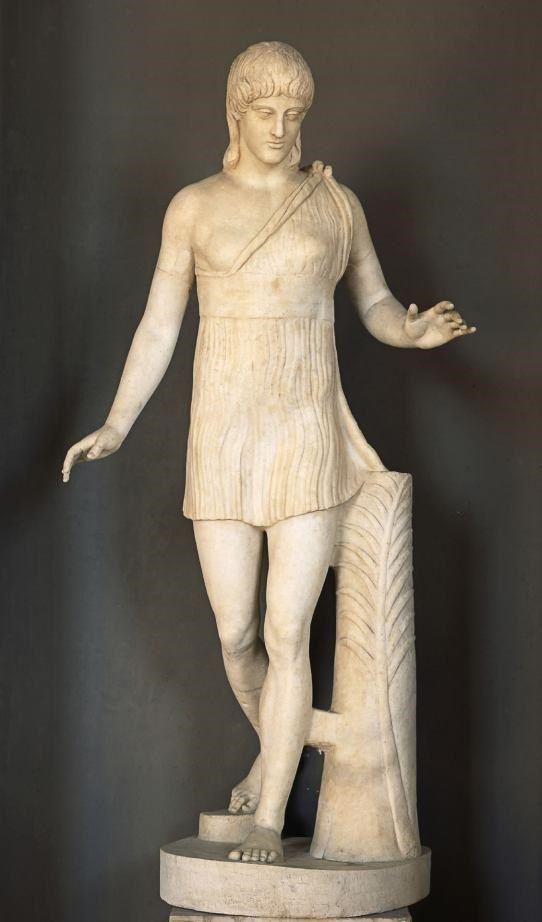
7. Runner (middle of the 5th century
B.C.)
And then I ask you to note,
as with Myron — as we come in to that age that one can denote
as the pinnacle — as with Myron, that a very different treatment
of the body arises, in that he no longer separates, what even here is
still the case, but he knows how to treat the whole body in connection
with the limbs.
 
8. Discus Thrower
Thus we stand in the middle
of the 5th century and find in such a shapes a tryly high degree of
perfection in the direction, we have tried to characterize.
And now we come, or are
already in, to the Age of Periclean. From the time of Phidias, of whomwe
unfortunately know very little, you have the so-called Athena Lemnia:

9. Athena Lemnia
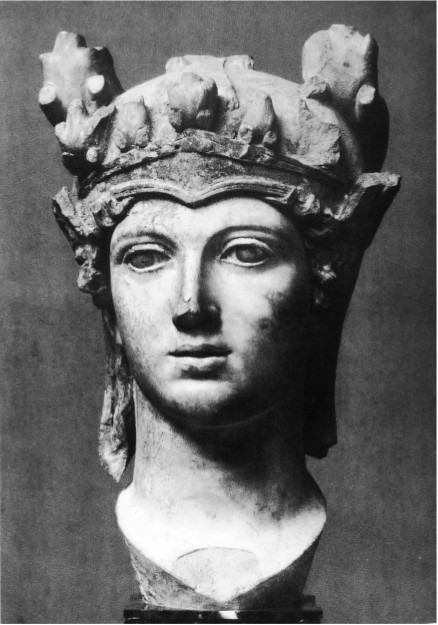 
10. Head of Athena
We will now give a few
examples of the famous Parthenon. You may read the interesting story of
these figures in any History of Art. The greatest of them have in all
probability been lost. We can only gain some idea of them from the
drawings made by the Frenchman, Carrey, in the 17th century. Subsequently
they were largely destroyed by the Venetians, and only the relics were
discovered by Lord Elgin in the 19th century.


11a. Drawings of the eastern pediment.
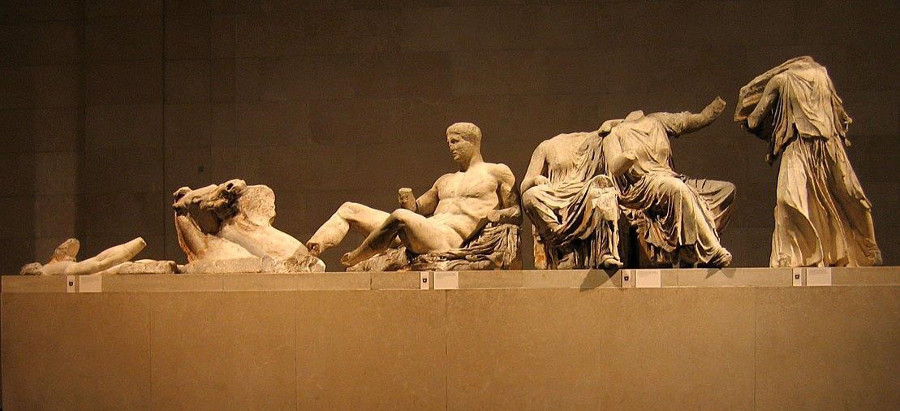
11b. Remains of the left side of the eastern pediment. (Bristish
Museum. London.)

11c. Reconstruction of the figures in the last photo.

11d. Hestia, Dione, and Aphrodite from the right side of
the eastern pediment. (British Museum, London.)
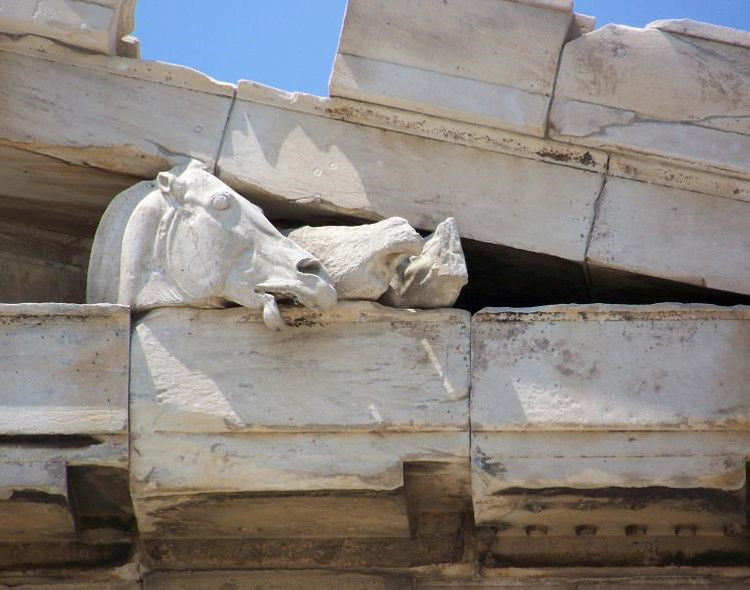
11e. Far right of the eastern pediment.
Now for the Parthenon western pediment:


11f. Drawings of the western pediment.


11g. Reconstruction of the western pediment.

The Parthnon Friezes:

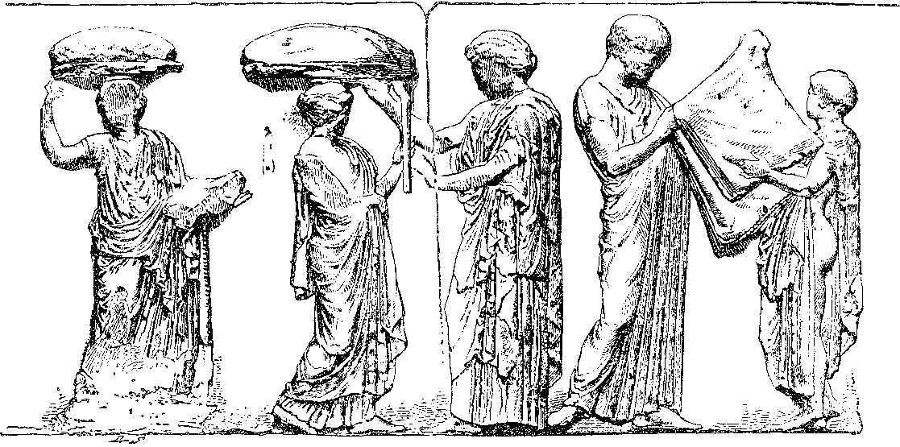

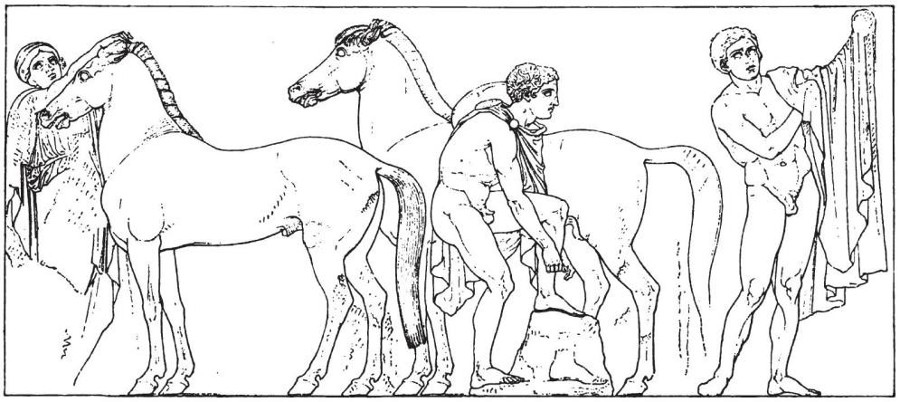
12a. Drawings of the Friezes.


12b. Calvary. (Western Frieze.)
We may assume that these
works were mostly executed in the presence of Phidias himself by his
pupils. The next group is from the Eastern Frieze:
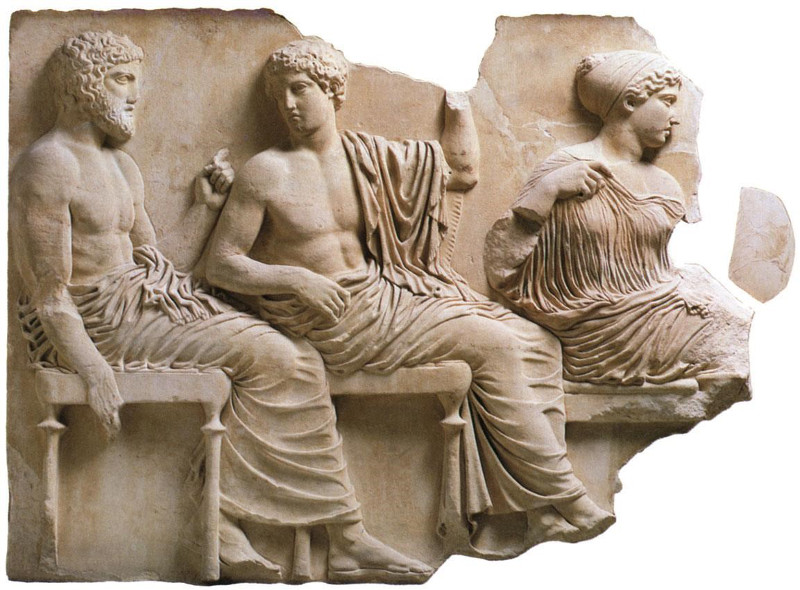

12. Poseidon Group. (Eastern Frieze.)
With Phidias, indeed, all
that was typical of Greek Art was already given. The stamp, the signature,
as it were, was now given to the bodily figure, as it should be represented
in Art. The way in which Phidias and his pupils saw it lived on for
a long time. It was felt that the line of the face, the features, the
movement of the limbs, the flow of the drapery and so forth, should
accord with what was evolved in this ideal age.
Through all the traditions
this was handed down, even into the times when they were able to imitate
quite superficially what had lived so strongly in this Golden Age of the
Art of ancient Greece. Unhappily, the greatest works have been destroyed.
It is no longer possible to gain by outer vision a conception of Phidias'
greatest masterpieces, which were transcendent and sublime. We must
realise that in the 18th century, when Goethe and others, stimulated
by Winckelmann, entered so deeply into the essence of Greek Art, they
could only do so with the help of poor, late imitations. Truly, great
intuition was necessary to penetrate into the nature of Greek Art through
the poor imitations that were then available. And if we really try to
feel the truth about these things we cannot but admit: In the time when
Goethe was a young man, or when he travelled in Italy, there was still
quite a different instinctive feeling for Art than later in the 19th
century, — let alone the 20th. For otherwise it would have been
impossible for these late imitations to inspire the lofty conceptions
of Greek Art which lighted forth in Winckelmann or in Goethe.
Look, for instance, at the
next, the head of Zeus, which is to be seen in Rome:
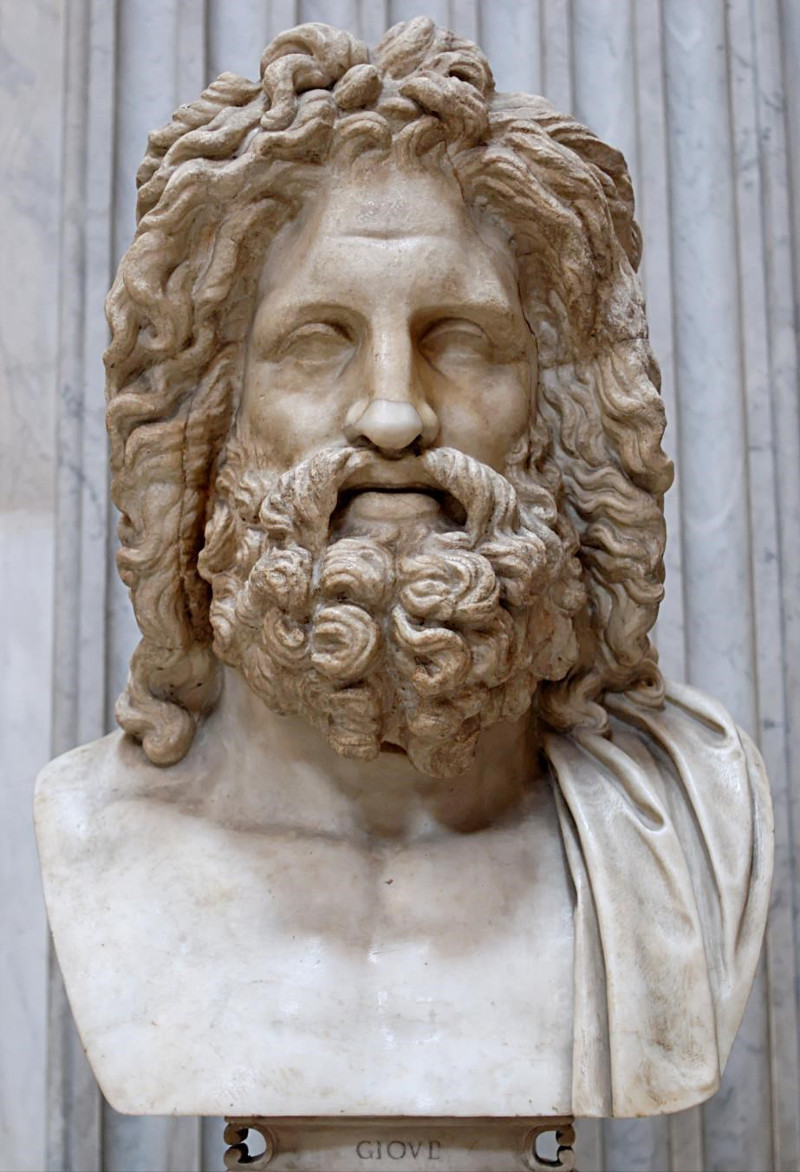
13. Zeus of Otricoli. (Vatican. Rome.)

14. Athena
Here you can see something
like a later continuation of the type that was evolved in the time of
Phidias. This is, of course, a later imitation, though undoubtedly it
still appears with a certain grandeur, — With a far less grandeur
they imitated the Hera type which had been evolved by Polycleitus. And
as to the famous Pallas Athene, which is also to be seen among these
statues in Rome, here I must say the imitation has become insipid, fatuous.
Indeed, this figure shows already the type of the later imitations of
Pallas Athene. These things even become a little reminiscent of
fashion-plates! We can but divine how magnificent were the works from
which these later imitations were derived.
In this head of Zeus you
see the tradition that was handed down from Phidias.

14a. Zeus
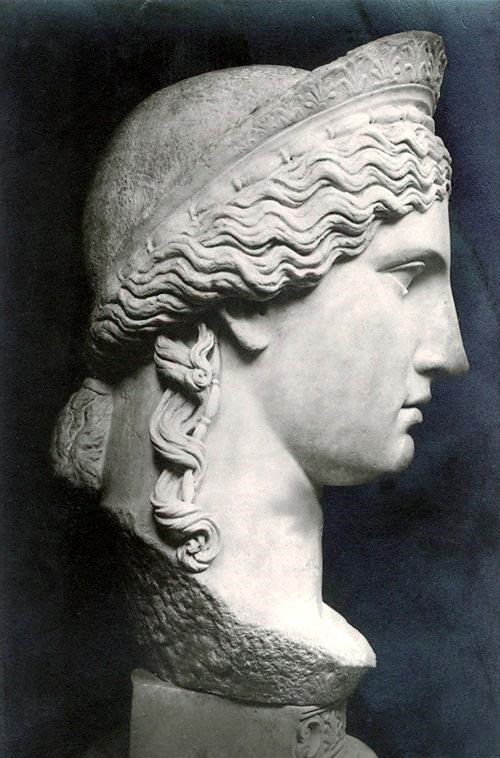
14b. Profile of Zeus.
And now we will go back
to the figures from the temple of Zeus at Olympia. Here, too, the composition
is magnificent:


15. Western Pediment. Temple of Zeus at Olympia.
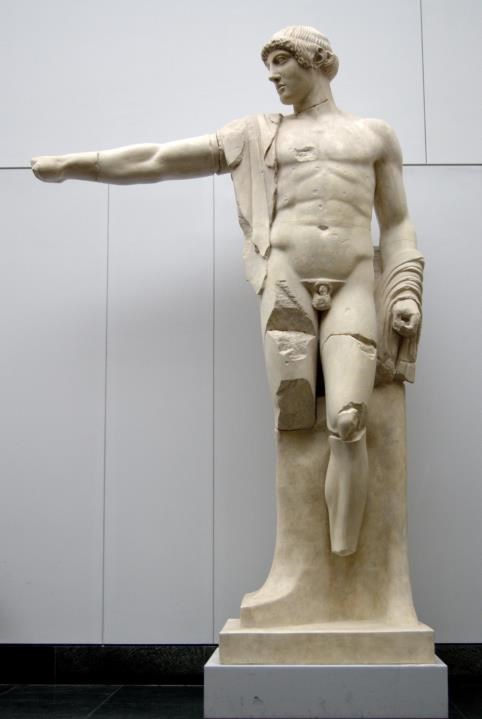 
16. Figure of Apollo.
The next, too, is from the
School of Phidias: —
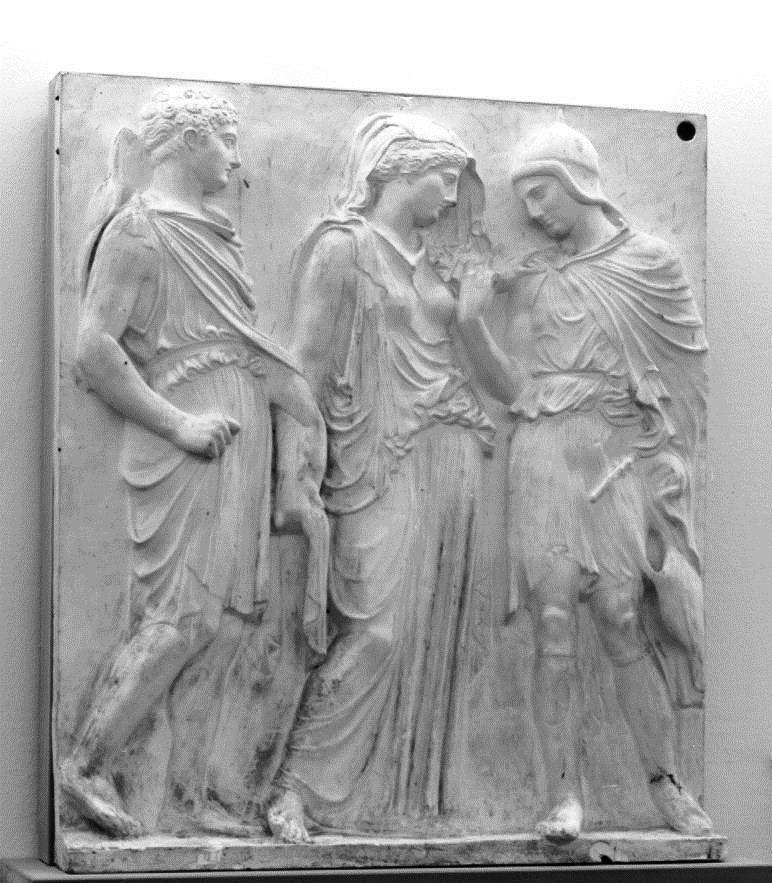
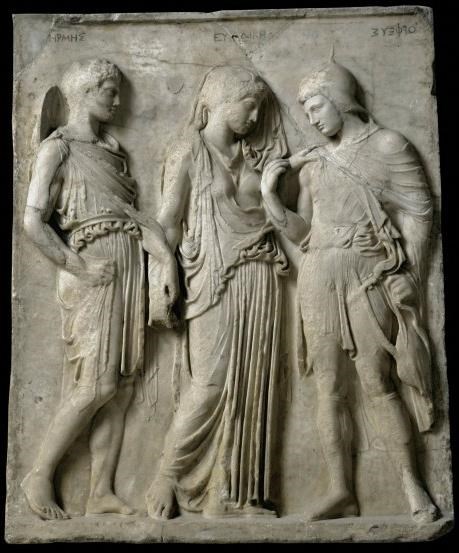
17. Orpheus Relief. (Museum. Naples.)
We remember how Phidias
was accused by his fellow-citizens of stealing gold for his gold-and-ivory
statue of Athene. His “grateful” fellow-citizens threw him
into prison.

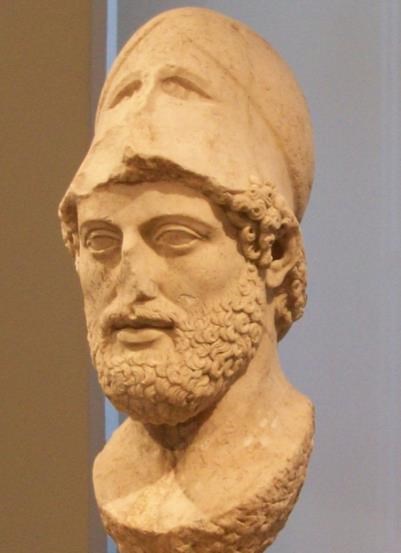
18. Bust of Pericles. (Berlin.)
Truly an ideal conception
— lifted far beyond the sphere of portraiture.
The next is perhaps a work
of Phidias' youth. —
 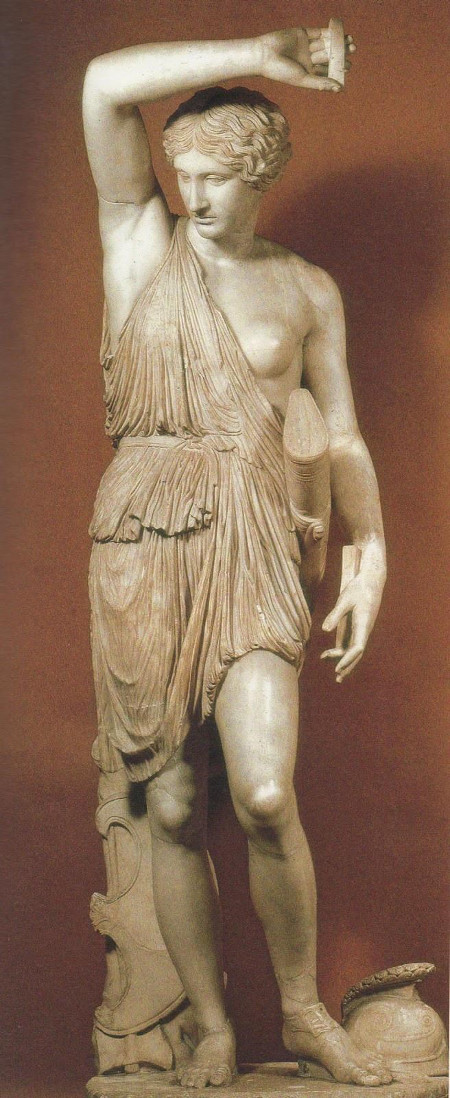
19. Amazon.
Here we will insert a work of Polycleitus: —
  
20. Amazon.
Myron and Phidias are the
artists of the Golden Age of Grecian Art; they, indeed, created the
traditions.
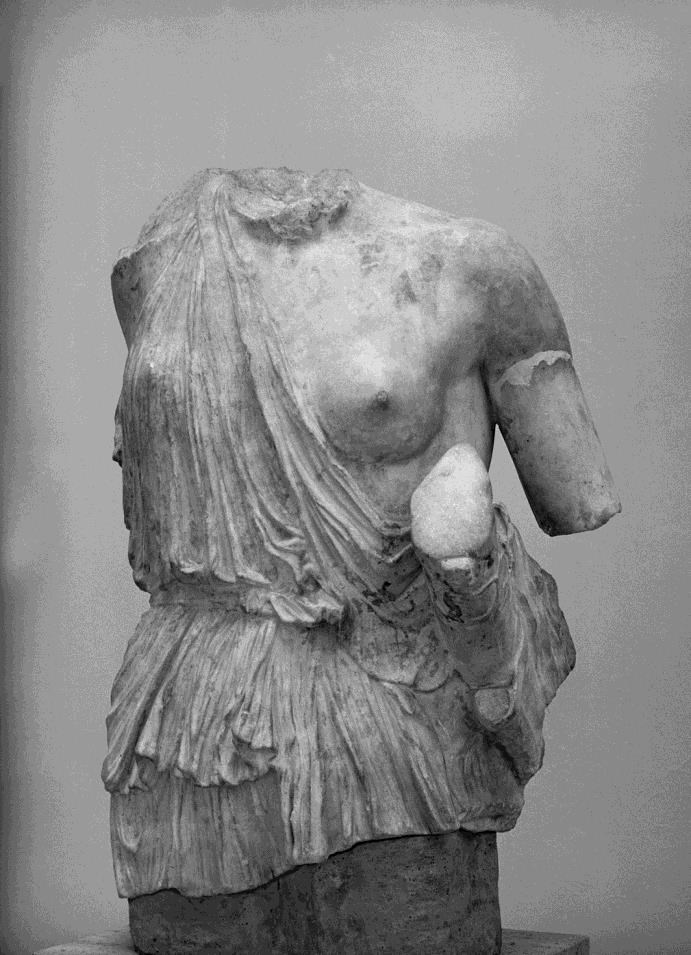
21. Amazon.
Another Amazon. The next
is more difficult to date; it represents about the turn of the 4th and
5th centuries
B.C. We insert it here to show that ancient Greece
was quite capable of producing something of the character of Genre: —
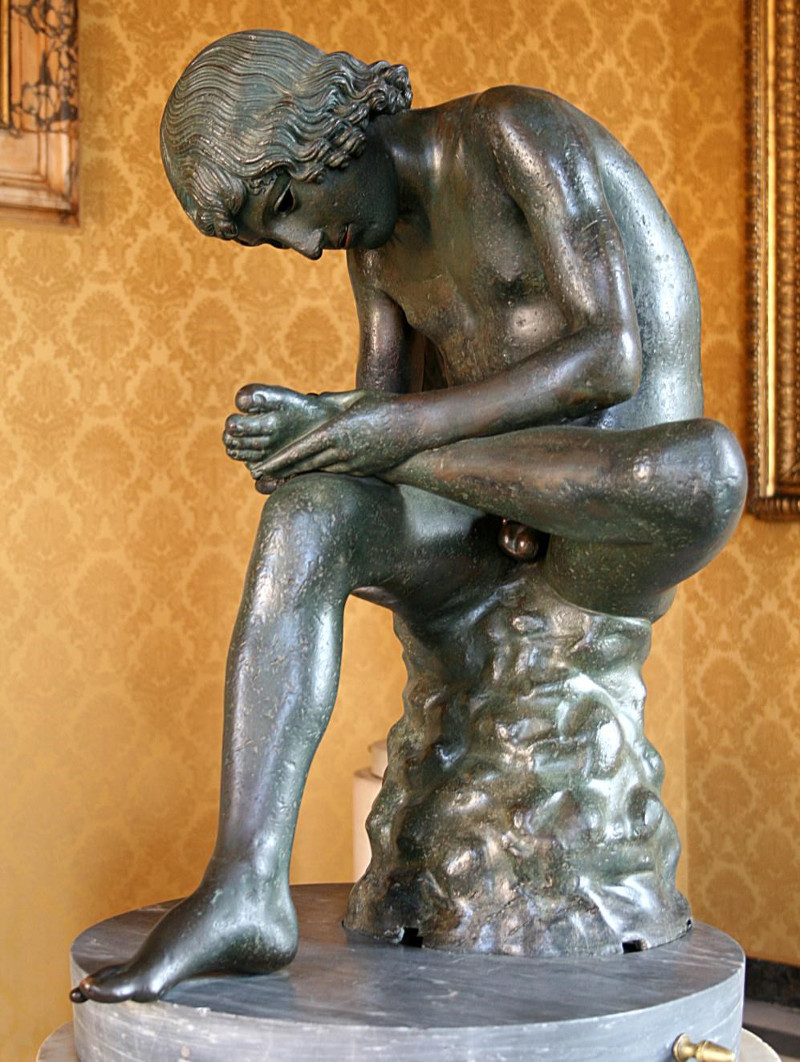
22. Boy, extracting the Thorn from his Foot. (Rome.)
And now we gradually come into
the age of which I tried to indicate just now that the whole conception
is lifted down into a more human realm, even though the figures be still
the figures of the Gods. Take the following, for instance: —

23. Aphrodite of Cnidos. (Vatican, Rome.)
Although it is the figure of
a Goddess, it is brought down into a more human sphere. The sublimity of
the earlier artists is made more human. We see this already in Praxiteles.
This picture represents the so-called Aphrodite of Cnidos. Praxiteles
brings us to the 4th century
B.C. In connection with this we will also
show the

24. Demeter of Cnidos. (British Museum.)
It breathes the same spirit.
The next is the Hermes of Olympia:

25. Hermes of Olympia, (By Praxiteles.) — holding
the Dionysos child in his left hand.

26. Satyr, by Praxiteles. (Capitol. Rome.)
To the same epoch belongs
the famous Niobe Group, — Niobe losing all her children through the
wrath of Apollo.

27. Figure in Flight, from the Niobe Group. (Vatican.
Rome.)
Going on into the 4th century,
we come into the Alexandrian age. Lysippus actually worked in the service
of Alexander the Great.

28. Bust of Alexander. (Louvre. Paris.)
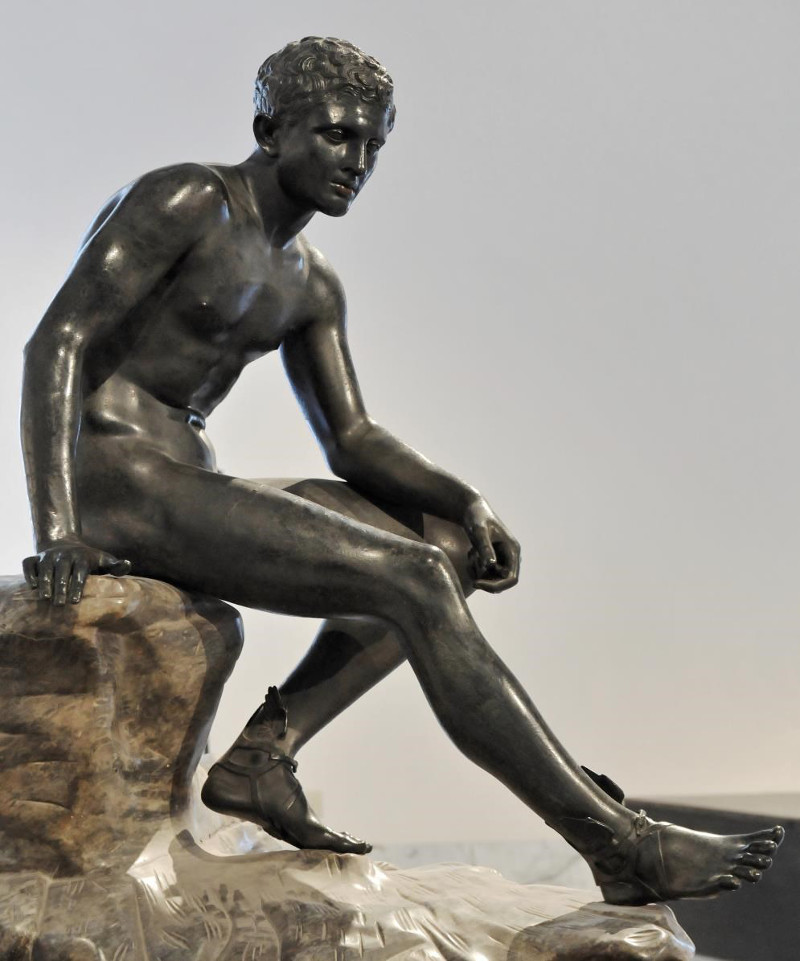
29. Hermes. (Museum. Naples.)
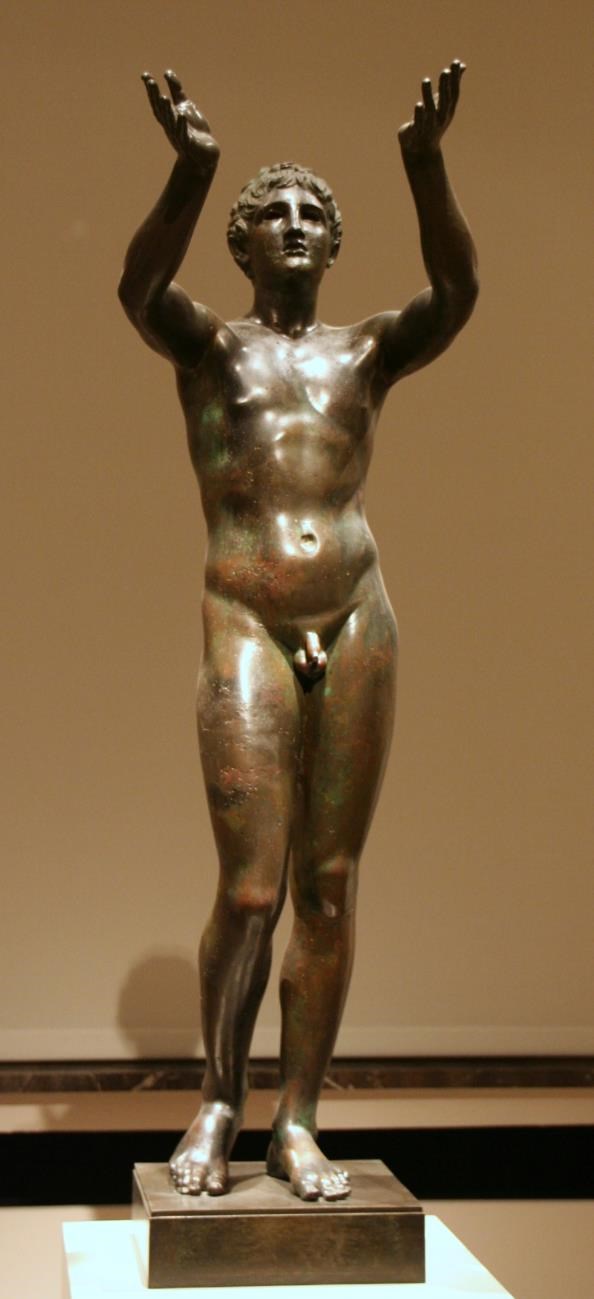
30. Youth, in Adoration. (By Lysippus.) (Berlin.) His
arms are lifted up to Heaven in reverence, in prayer.


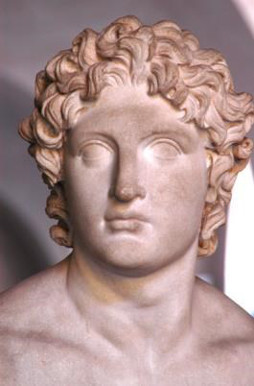
31. Alexander the Great. (Munich.)
Here we already see the
descent of Art from the Typical to the Individual — though in
the Grecian Art the process nowhere went as far as in the later epochs.
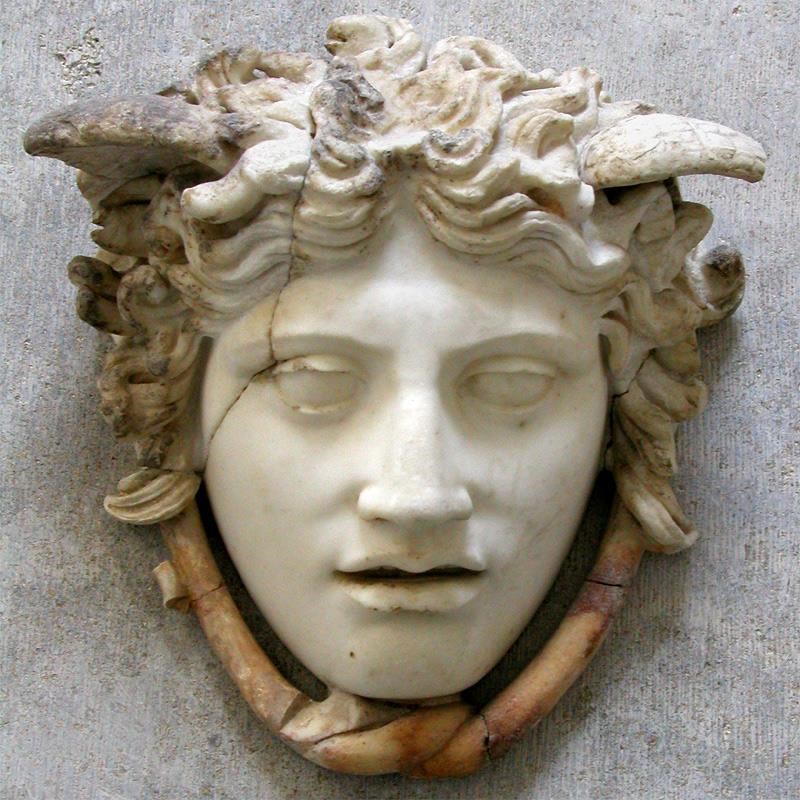
32. Medusa Head. (Glyptothek. Munich.)
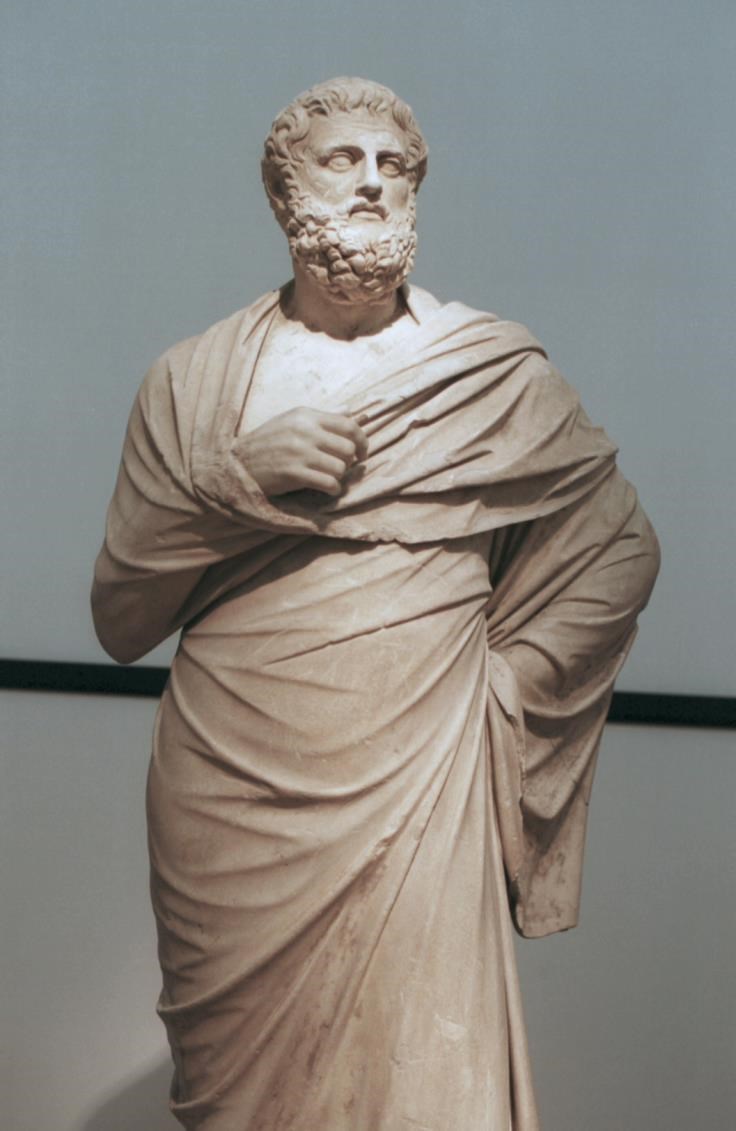
33. Sophocles. (Vatican. Rome.)
This status reaches back
again to the best, ideal tradition of the older times; it reminds us
of the Golden Age. We might equally well entitle it: The Poet, as such.
This is symbolised by the rolls of script which are put there of set
purpose. Compare this with the figures that now follow, tending more
or less towards a portrait likeness in each case. You will see how they
strive away from the ideal type, towards the quality of portraiture.
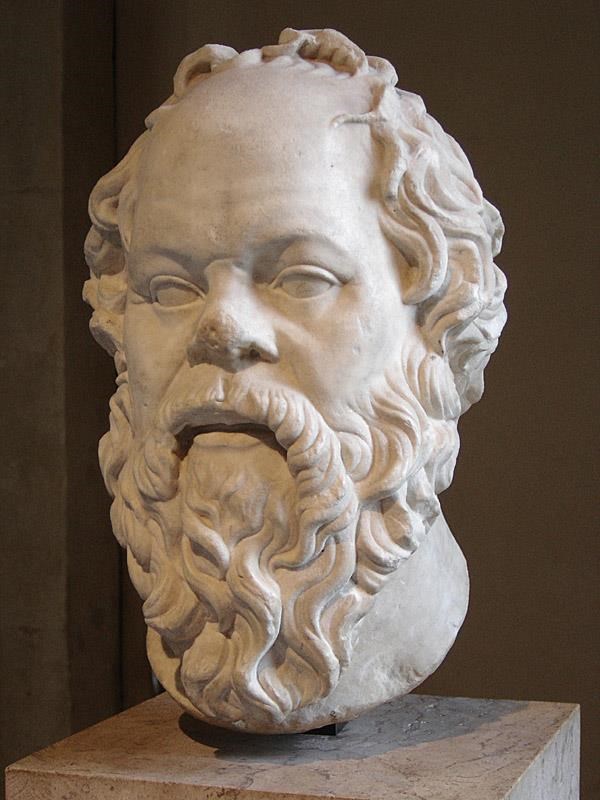
34. Socrates.
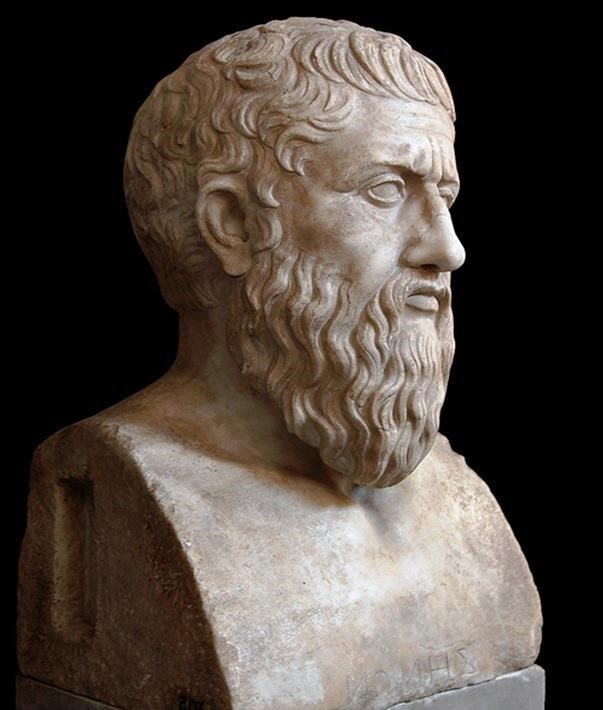
35. Plato. (Vatican. Rome.)
Of course, these portraits
are not done from the model, but still there is an attempt at a human
likeness — by which I do not mean to say that they are really like
the original.
These remarks will refer
especially to the Homer which will now follow: —

36. Homer. (Museum. Naples.)
Now we gradually approach
the 2nd century.

37. The Victory of Samothrace. (Louvre. Paris.)

38. The Venus of Milo. (Louvre. Paris.)
This famous work does, indeed,
preserve the tradition of the Golden Age, although it belongs to a later
period.
In the next picture, on
the other hand, we see a fresh attempt to bring in movement: —
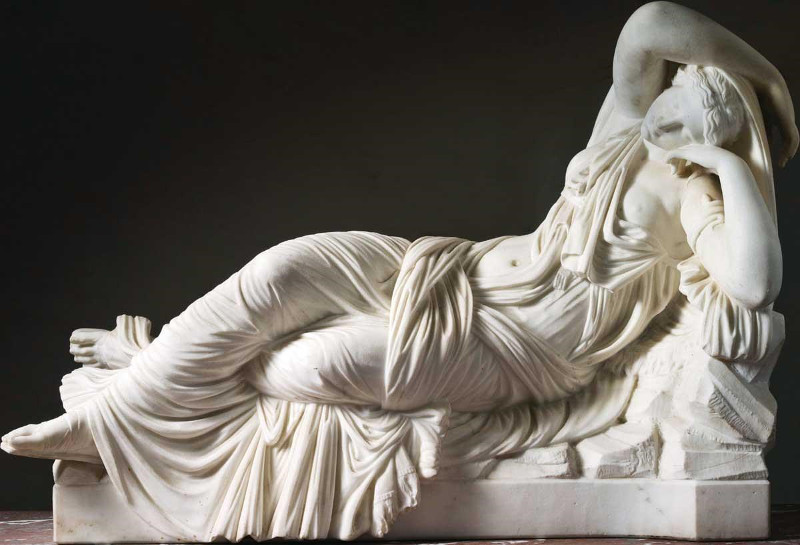
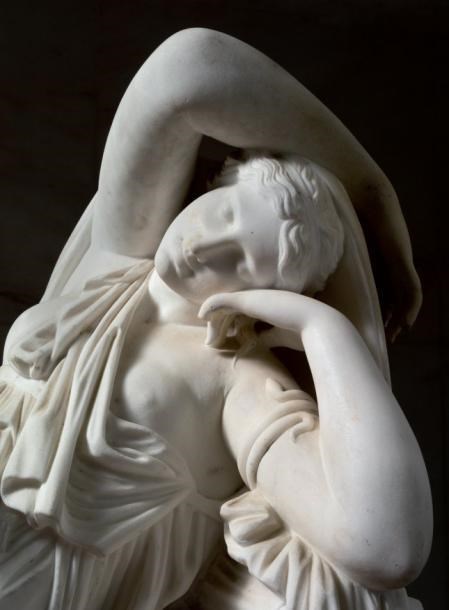
39. Sleeping Ariadne.
This is probably a work
of the same period, but you will see a distinct contrast between the
two.
And now we come towards
the last century before the birth of Christ. We come to the School of
Rhodes.
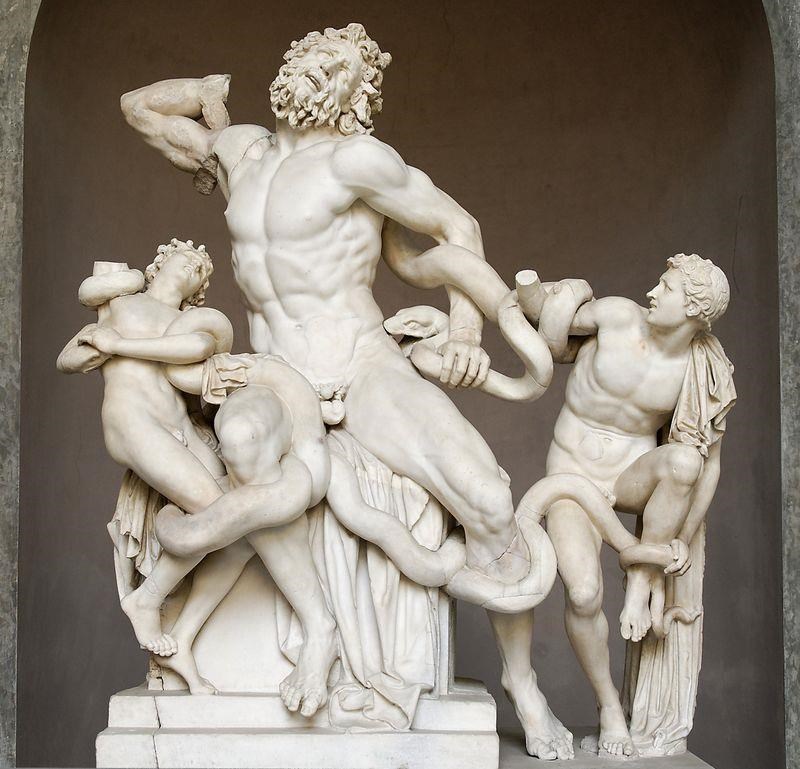
40. Laocoön. (Vatican. Rome.)
This is the famous
Laocoön group — the starting-point, as you know, of many an
artistic discussion, ever since Lessing's Laocoön of the 18th
century. It is the work of three sculptors of the School of Rhodes.
Lessing's writings on this subject are, indeed, most interesting. He
tried to show, you will remember, how the poet describes is not placed
before the eyes. We must call it to life in our imaginations. Whereas
what the plastic artist has created is there before our eyes. Therefore,
says Lessing, what the plastic artist portrays must contain far more
repose; it must represent moments which can at least be imagined —
for a single moment — in repose.
Much has been said and written
about this Laocoon group, especially in relation to Lessing's explanations.
It is interesting how the aestheticist, Robert Zimmermann, — without,
of course, having any knowledge of Spiritual Science — arrived at an
explanation which needs, no doubt, to be supplemented, but which was none
the less correct for an age that had not Spiritual Science. His explanation
contains — albeit only as an instinctive suggestion — some
element of what I have been setting forth today. We see the priest,
Laocoon, with his two sons, wound around by the serpents and going towards
their death. Now we cannot but be struck by the peculiar way in which
the body has been moulded. Much has been written on this subject. Robert
Zimmermann rightly pointed out: The whole representation is such that
we have before us the very moment where the life (or, as we should say,
the etheric body) is already fleeing away. It is already a moment of
unconsciousness. Hence the artist represents it as though the body of
Laocoon were already falling asunder. That is the marvellous quality
about this figure. The body is already being differentiated into its
parts. Thus even in this late product we see how the Greek was aware of
the etheric body. He brings to expression the actual moment where life is
passing into death. It is the quick withdrawal of the etheric body through
the shock — the shock that is expressed by the awful snakes
coiling around. This effect of the etheric body withdrawing from the
physical, and the physical falling asunder, is the characteristic thing
in the Laocoon; not the other things that are so often said, but the
peculiar way the body becomes differentiated. We could not imagine the
body thus, unless we conceived it as the moment when the etheric body
is drawing away.
And now two more examples
— imitations of earlier works, perhaps, which have, none the less,
made a great impression on later students of Art.

41. Apollo Belvedere. (Vatican. Rome.)
This is the famous Apollo
Belvedere — Apollo represented as a kind of battle-hero.

42. Artemis. (Louvre. Paris.)
This, too, will be a later
imitation of an earlier work.
Now, as we know, the Art
of the ancient Greece gradually drew near its decline, when Greece was
subjugated by Rome. In Rome, to begin with, there was a kind of imitation
of the Greek Art. It was carried across to Rome, but it was soon submerged
in the widespread unimaginativeness of the Roman people, to which we
have frequently referred.
The next centuries, as you
know ... were to a large extent a dark and troubled age for our evolution.
Then a new age began. I will only repeat quite briefly: — In the 12th
and 13th centuries in Italy, when through manifold circumstances they
rediscovered some of the ancient works of Art that had been buried in
the early Middle Ages, the contemplation of the ancient works kindled
the rise of a new Art, which grew in time into the Art of the Renaissance.
From the 13th century onwards, artists would educate themselves by means
of the Antique — the works of Art that had been found or excavated,
though the number at that time was relatively small.
We will now consider this
re-discovery of the ancient Art in the period immediately preceding the
Renaissance. In Niccola Pisano in the 13th century we find a wonderfully
refined spirit who waxed enthusiastic over the relics of Greek Art, and
tried to create once more in the spirit of the Greeks — out of his
own imagination fructified, as it were, by the Greek Art itself.
Our first picture is the
famous pulpit in the Baptistery at Pisa; note the reliefs in the upper
portion: —

43. Niccola Pisano. Pulpit in the Baptistery at Pisa.
The pulpit is supported
by antique columns between which are Gothic arches. Underneath are also
lion figures; above are the relief in which he expressed so wonderfully
what he owed to the inspiration of the antique. Niccola Pisano worked
until the end of the 13th century.


44. Niccola Pisano. Adoration by the Three Wise
Men. (Relief. Details of the above.)
Another representation of
the same subject: —

45. Niccola Pisano: The Crucifixtion. (Relief.
Pulpit in the Cathedral at Siena.)
We now go on to Giovanni
Pisano. In his works you will observe already a far greater element
of movement. A certain quietude pervades all the figures of Niccola
Pisano.
 
46. Giovanni Pisano. Pulpit. (San Andrea. Pistoja.)
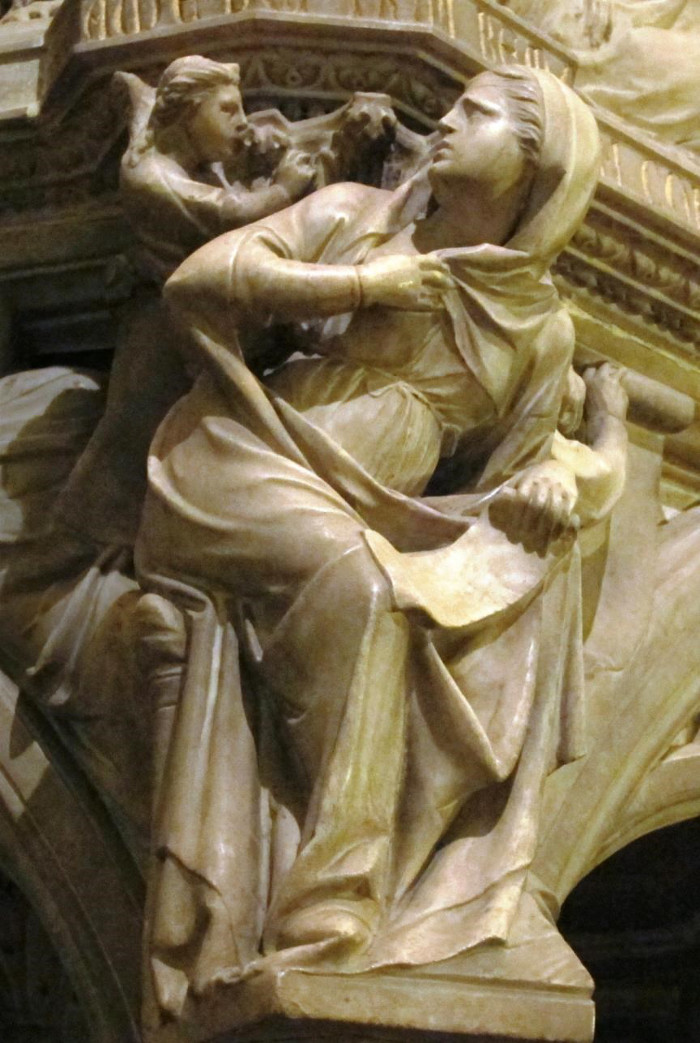
47. Giovanni Pisano. Capital from the above Pulpit.
Truly, it was due to the
stimulus and inspiration of the Antique, arising, to begin with, in
the Pisanos, that the Christian Art afterwards became able to express
its motifs so perfectly as it did in
the Renaiscance.
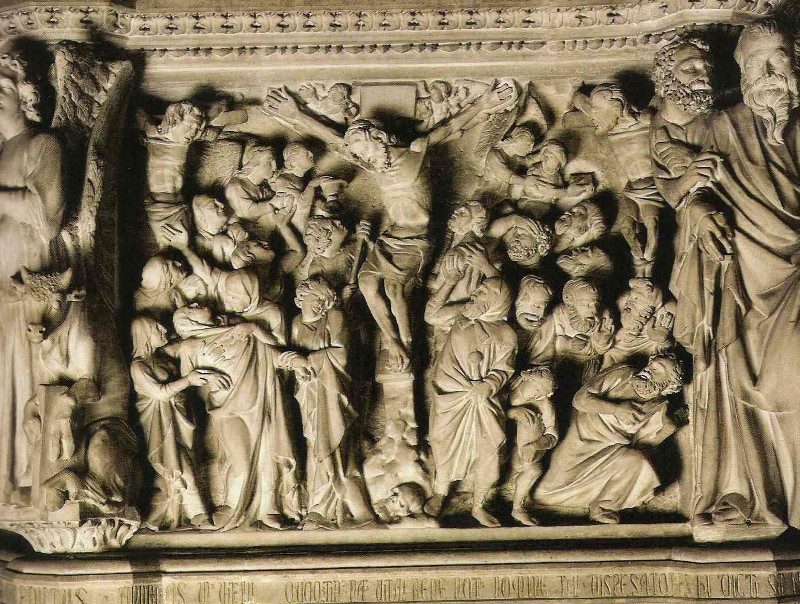
48. Giovanni Pisano. Bas-Relief from the same Pulpit.
The next two are by Giovanni Pisano: —

49. Giovanni Pisano. Pulpit in the Cathedral at Pisa.
We see at the same time
how naturally the Antique grew together with the Gothic.
And two Madonnas from him:

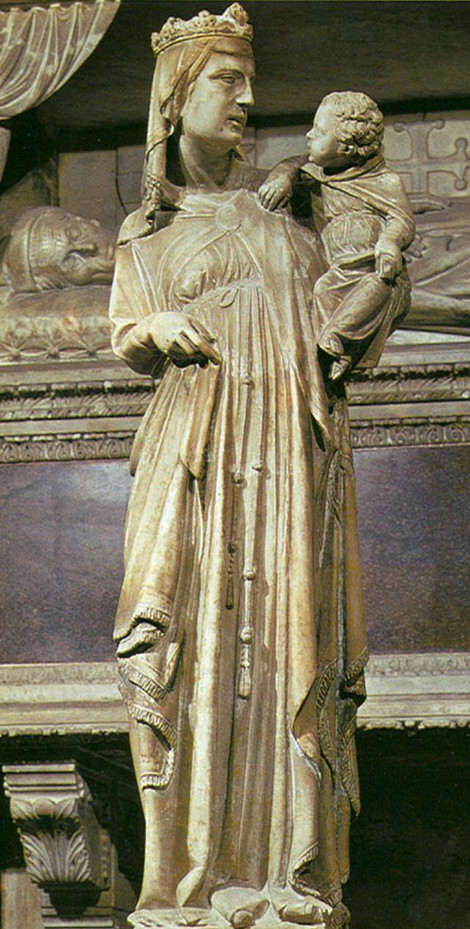
51. Giovanni Pisano. Madonnas. (Berlin and
Padua.)
And now we have a sample
of the work of Andrea Pisano, who was summoned to do one of the Bronze
gates of the Baptistery at Florence.

52. Andrea Pisano. Tubal Cain. (Campanile.
Florence.)
A Bas-Relief representing
Tubal Cain, inventor of the craft of metallurgy according to the Bible,
the Old Testament.
We have thus approached the
15th century, and we come to Ghiberti, the great artist who at the age of
twenty years was already able to compete with the others in designing
the doors of the Baptistery in Florence.

53a. Ghiberti. The Offering of Isaac. (Baptistry. Florence.)

53b. Ghiberti. Northern Door of the Baptistery in Florence.
At the early age of twenty he
was already allowed to do the Northern Portals. From a simple goldsmith's
apprentice he grew to be one of the very greatest artists. These
bas-reliefs of the doors of the Baptistery in Florence are, of their kind,
among the greatest things in the whole evolution of Art. Afterwards the
Eastern door was also given to him to do. It represents scenes from the
Old Testament. Michelangelo said that these were worthy to be the gates
of Paradise.
[Note: the doors at the
Florence Baptistery were moved causing some confusion as to where the
works of Ghiberti and Andrea Pisano are located. – e.Ed.]

54. Ghiberti. The Gates of Paradise. (Baptistery. Florence.)
This work had, indeed, a
great influence on the whole Art of Michelangelo himself. Even in the
details we can recognise certain motifs in Michelangelo's paintings,
which he took from these bronze reliefs.

55a. Ghiberti. Sacrifice of Isaac. (Detail from the 'Gates
of Paradise.')

55b. Ghiberti. Creation of Man. (Detail from the 'Gates
of Paradise.')
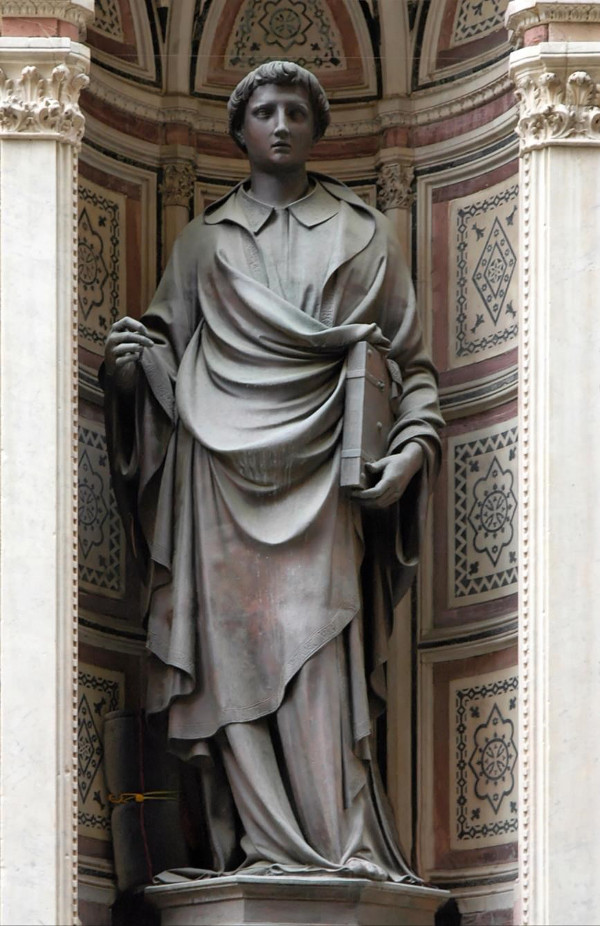
56. Ghiberti. St. Stephen
These works of Ghiberti's
were undoubtedly due to a faithful contemplation of the Antique.
We will now insert the Art
of the della Robbias. To begin with: —

57. Luca della Robbia. Dancing Boys. (Cathedral. Florence.)
The della Robbias are famous
as the inventors of a special art — the use of burnt clay as a
material. To a large extent their works were done in this material.
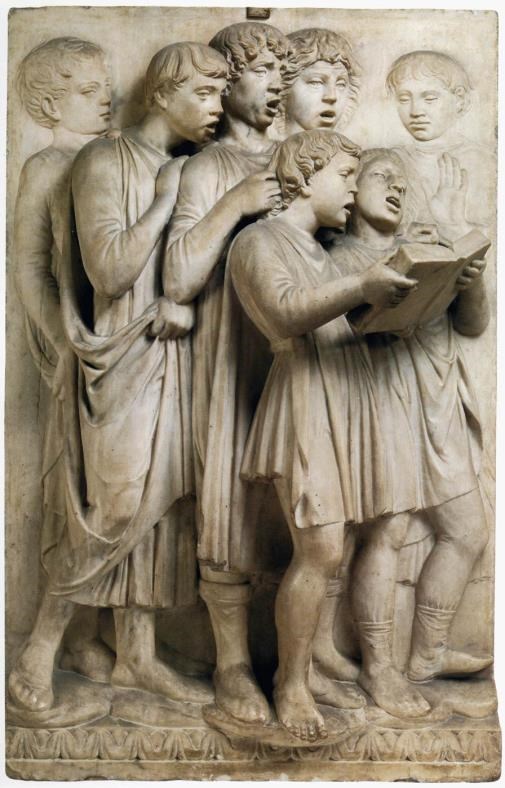
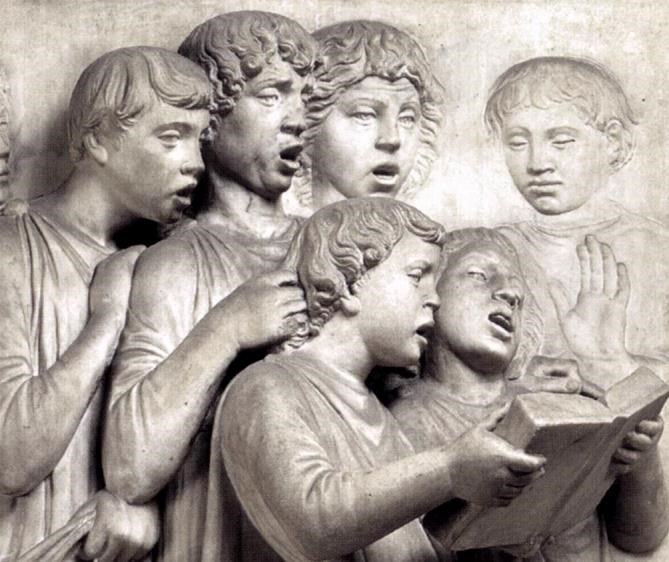
58. Luca della Robbia. Singing Boys. (Cathedral. Florence.)
Luca della Robbia covers
practically the whole period of the 15th century.

59. Luca della Robbia. Madonna in the Bower of Roses.
(Museo Nazionale. Florence. )
Observe once more the age
that we have now come into. The Art of antiquity that had been derived
from immediate inner experience — experience of the Etheric —
works as a great stimulus and inspiration. Yet at the same time the Art of
this age is founded on what is seen — the faithful representation of
what is actually seen. It is no longer based on something felt and sensed
inwardly. It is very interesting to receive the impression of the two
epochs, one after the other, in this way.

60. Andrea della Robbia. Bambino. (Spedale degli Innocenti. Florence.)
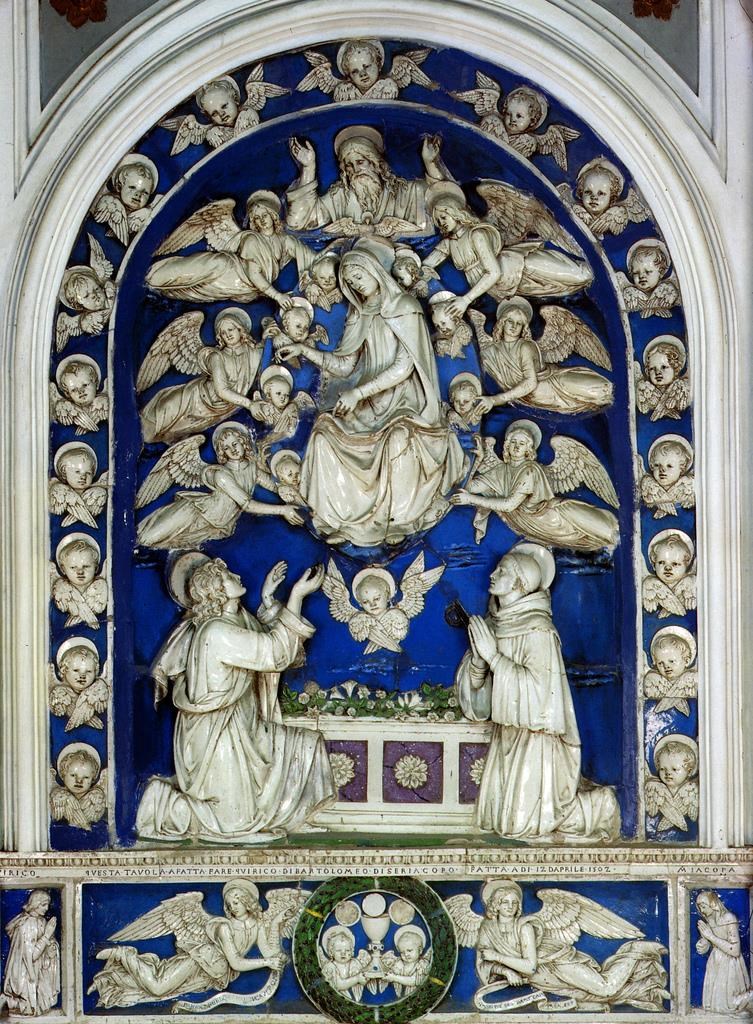
61. Madonna (della Cintola Fojano). Andrea della Robbia.
The Madonna is shown in
the spiritual world.


62. Giovanni della Robbia. Reception of the Pilgrims
and Washing of the Feet. (Hospital. Pistoja.)
We now go on to Donatello,
who was born in 1386. In him we observe the influence of the Antique
combined already with a decided tendency to Naturalism. His vision has
a naturalistic stamp. Donatello enters lovingly and sympathetically into
Nature. But while he becomes a real naturalist, he derived his technique
from what his predecessors had evolved out of the old tradition.
His naturalism went so far
that his friend and companion in his strivings, Brunelleschi, seeing
a Christ that Donatello attempted, exclaimed; “That is not a Christ
that you are doing, that is a peasant:” Donatello at first did not
understand what he meant. The anecdote is interesting, if not historically
true; it gives us a right impression of the relation between the two
artists — the contrast between the two artists — the contrast
between Donatello and Brunelleschi with his high idealism — immersed
as he was in the contemplation of the Antique, in its rebirth. Brunelleschi
thereupon himself undertook to model the Christ. Donatello — for
they lived together — had gone out to buy things for their breakfast.
He returned with all the dainties for their common meal wrapped up in a
kind of pinafore. Just as he entered, Brunelleschi unveiled his Christ.
Donatello gaped with wide open mouth, and his astonishment was such
that he dropped all the breakfast on the ground. What Brunelleschi had
achieved was a revelation to him. We cannot say that the impression he
experienced went very deep. None the less, Brunelleschi undoubtedly had an
ennobling influence on him. The above story goes on to relate, Donatello
was so overwhelmed that he even imagined the breakfast had disappeared.
“What have we now to eat?” he said. “We'll just pick the
things up again,” said Brunelleschi. “I see I shall never be
able to do any more than peasants,” said Donatello.
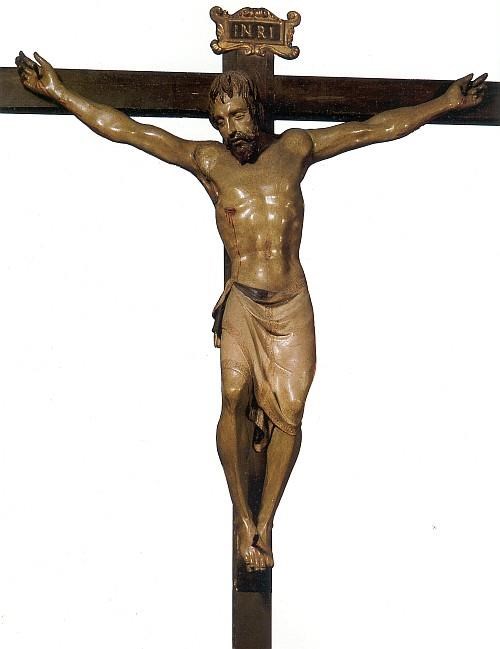
Donatello. Crucifix. (Florence.)

Filippo Brunellesco. Crucifix. (Florence.)

Donatello. David. (Florence.)
And now we come to the beautifully self-contained marble
statues by Donatello in Florence, showing his ability — out of
his naturalistic vision — to create human figures strong and firm,
even as he wanted them, their feet firmly planted on the ground.

63. Donatello. David. (Museo Nazionale, Florence.)
 
66. Donatello. Jeremiah. (Campanile. Florence.)

Habbakuk
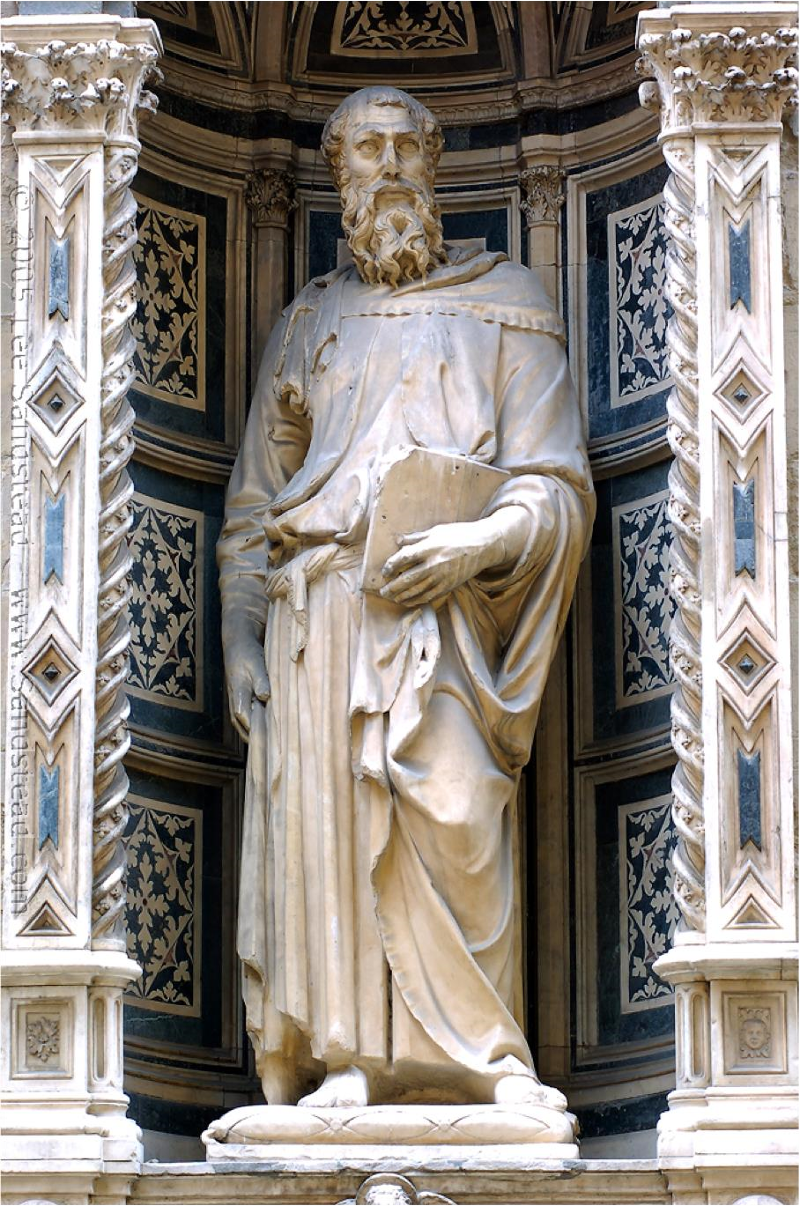
65. Donatello. St. Peter. (Or San Michele. Florence.)
 
67. Donatello. St. John Baptist. (Campanile. Florence.)
In Donatello Naturalism
certainly finds its way in. It is not the inner soul that we found in
the Northern sculpture, but a decidedly naturalistic vision of what
the outer senses see.

69. Donatello. Habakkuk. (Campanile. Florence.)
Niccola Pisano and Donatello were two artists who powerfully
influenced Michelangelo. Those who afterwards saw what Michelangelo
created — especially in his early period — remembered Donatello
and coined the phrase which then became current: Donatello Michelangelosed
or Michelangelo Donatelloised.
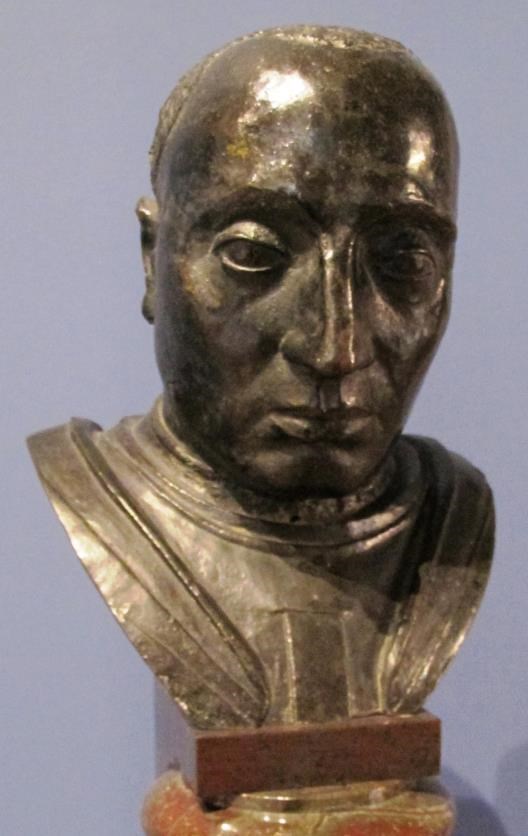
70. Donatello. Lodovico III Gonzaga
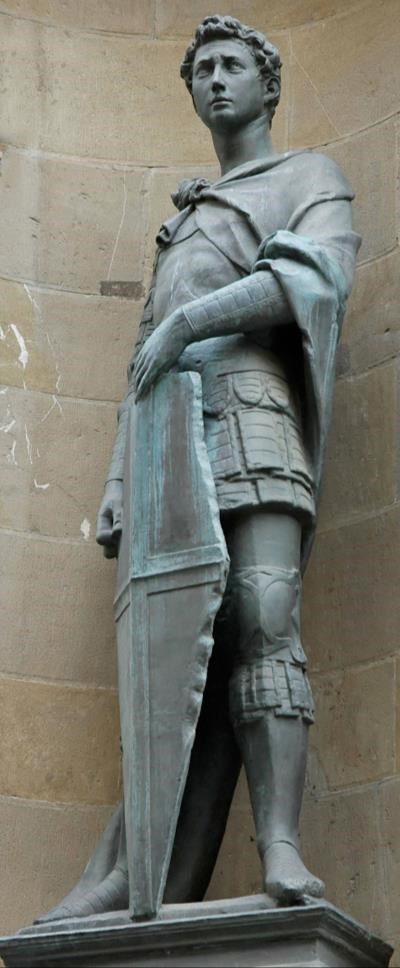

71. Donatello. St. George. (Florence.)
Most characteristic is this
St. George by Donatello. All the power of his naturalism is in it. Such
works of Art arose out of the freedom of the free city of Florence,
which also gave birth to Michelangelo.
By a wider historic necessity
— a cosmopolitan historic necessity, we might say, — it
was in Italy that the Antique came to life again. On the other hand,
the naturalistic tendency everywhere was bound up with the mood and
feeling that arose in the culture of the Free Towns or Cities. Here,
as in the North — though in different ways, of course, according
to the different characters of the people, — we find this element
arising out of the life of the free cities, where man became conscious
of his dignity, his freedom, his individual being. In the characteristic
works of Art which we found in the Netherlands and other Northern parts,
we were reminded again and again of the life of the free cities and the
feeling that pervaded them. And so it is here, when we look at this figure
of a man, so firmly established in the world of space, this Florentine
St. George. We cannot but think of the civilisation of the Free Cities,
whose atmosphere made such a thing possible.

72. Donatello. Bas-Relief. St. George and the Dragon.
(From the Base of the St. George Statue.)

73. Donatello. Madonna Pazzi. (Berlin.)


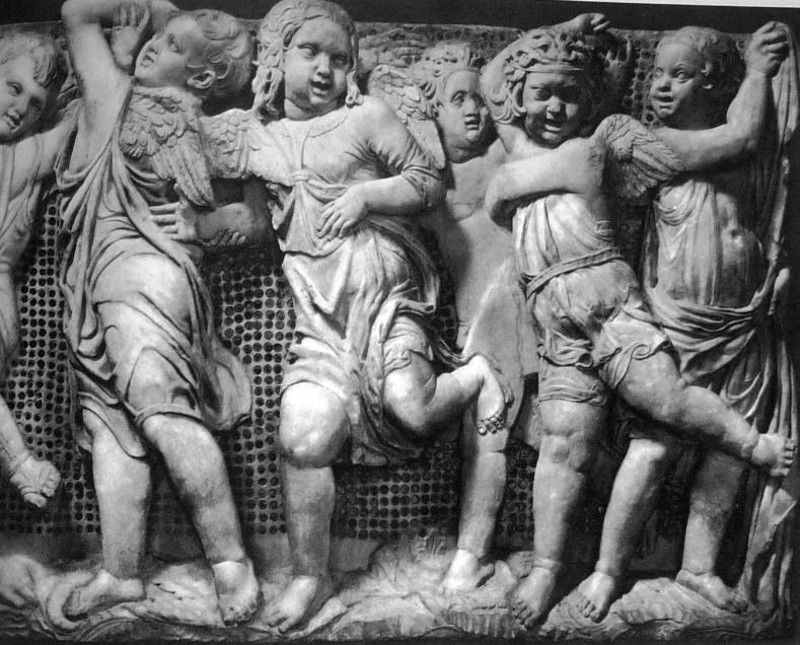
74. Donatello. Bas-Relief. Angels Singing. (Uffizi.
Florence.)
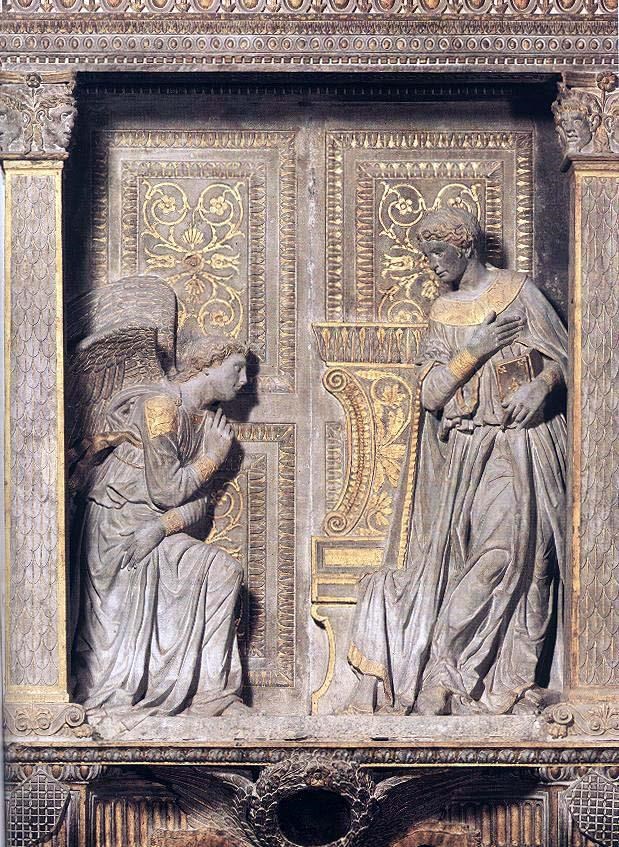
75. Donatello. Annunciation. (Santa Croce. Florence.)
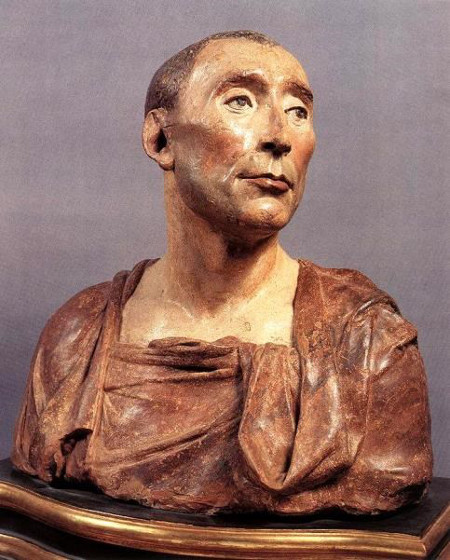 
76. Donatello, Portrait of Niccolo da Uzzano.
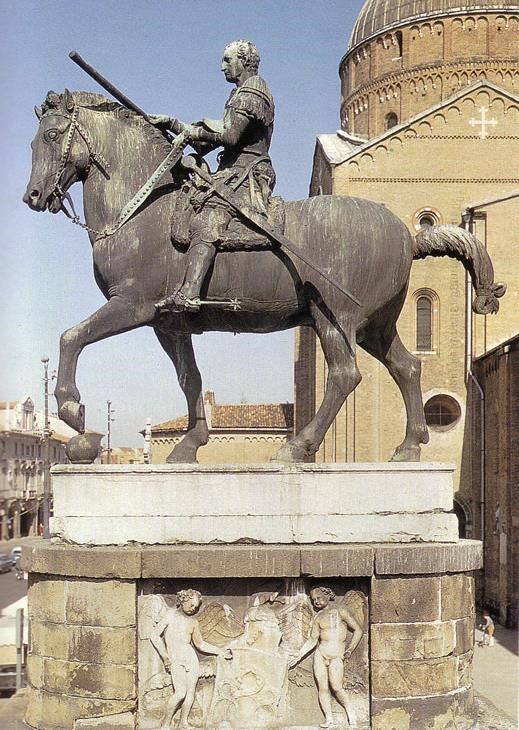
Donatello. Gattamelata.
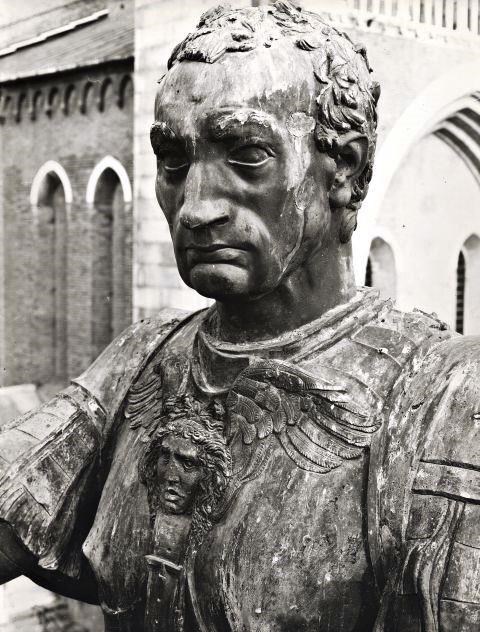 
Donatello. Gattamelata.
Finally, we will show some
examples of Verrocchio — teacher of Leonardo and Perugino — in
his capacity as a sculptor. First the famous equestrian statue: —
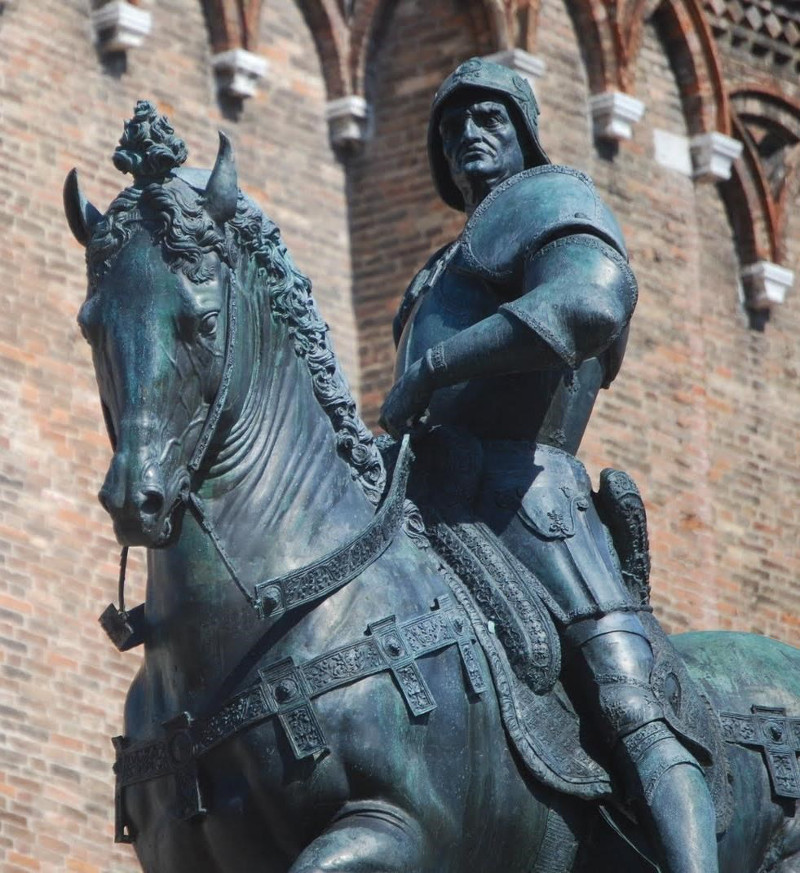
77. Verrocchio. Bertolomeo Colleoni. (Venice.)
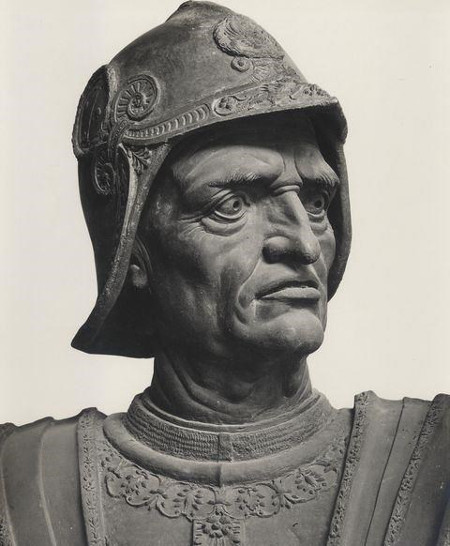 
79. Verrocchio. Head and Shoulders. (Detail of the above.)
80. Verrocchio. Guiliano de Medici. (Paris.)
And in conclusion: —
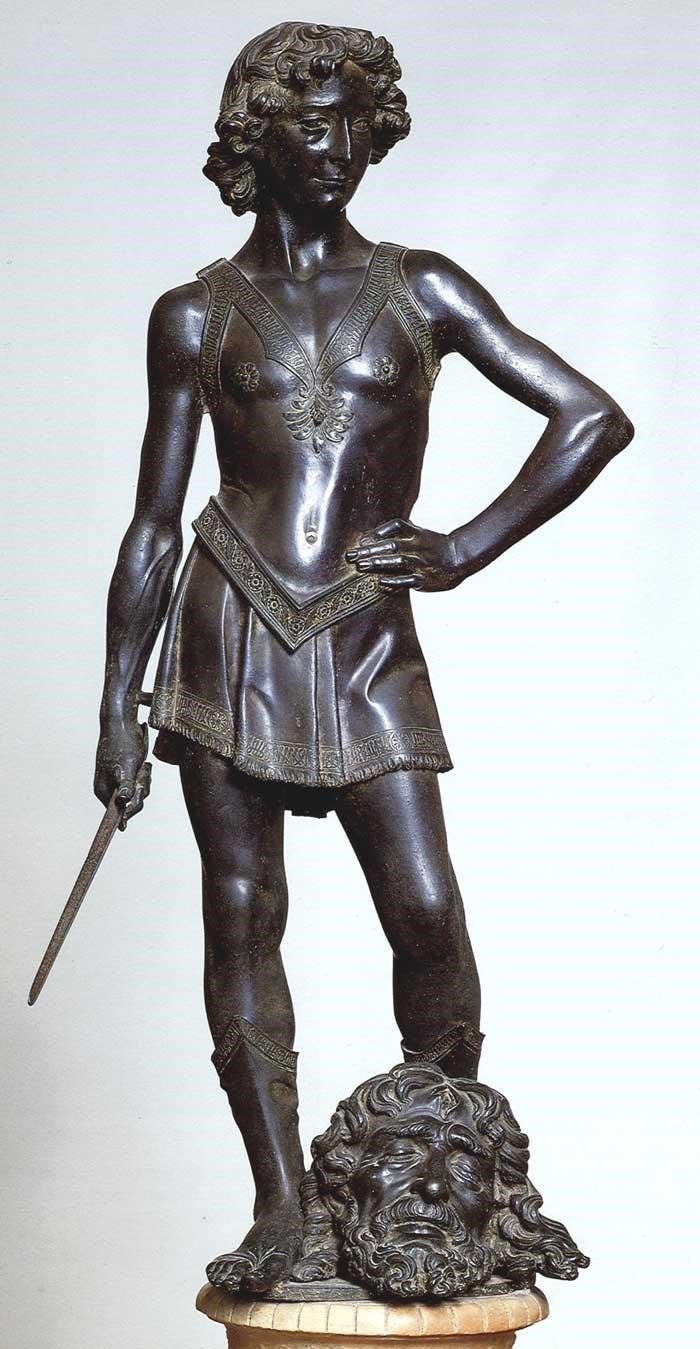
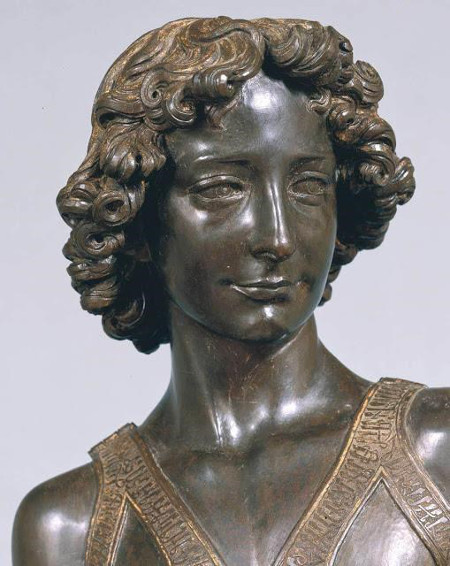 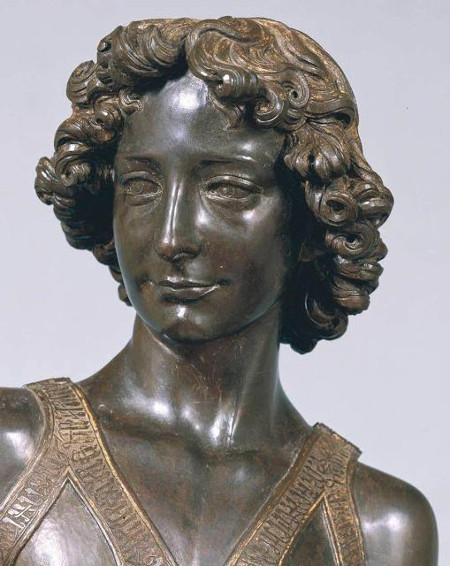
81. Verrocchio. David. (Museo Nazionale. Florence.)
And so, my dear friends,
we have had before us the artists of the pre-Renaissance. They entered
deeply into the Antique and brought it forth again, in a time when men
no longer lived within the soul in the same inward way as did the ancients.
They brought to life again in outer vision, contemplation, what the
ancients had felt and known inwardly — what they had feelingly known,
knowingly felt, I should say. Moreover, they united this with the element
which had to come in the 5th Post-Atlantean epoch — the element of
naturalism, with clear outward vision. They thus became the fore-runners of
the great artists of the Renaissance — of Leonardo, of Michelangelo,
and, through Perugino, of Raphael himself. For all these were influenced
directly by the Art of the precursors, whose works we have seen today.
They stood, undoubtedly, on the shoulders of these artists of the pre-
Renaissance period, the early Renaissance.
It is interesting to see,
in relation to this figure, for example, how quickly they progressed
in that time. Compare this David with the David by Michelangelo. Here
you still see a comparative inability to dramatise the theme —
to take hold of it in movement. Michelangelo, on the other hand, in
his David, has seized the very essence of dramatic movement; he has
caught the actual moment of resolve to go out against Goliath.

82. Michelangelo. David, Marble Statue
(Florence, Academy)
Thus we have tried to bring
these things to some extent before our souls: — On the one hand what
radiates from the Greek Art itself, and on the other, its lighting-up-again
in the age when Humanity was trying to find the life of Art once more
with the help of the Greek Art which came to life again.
|